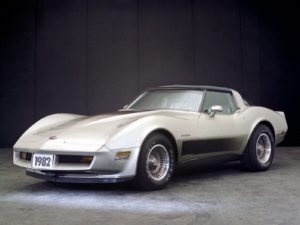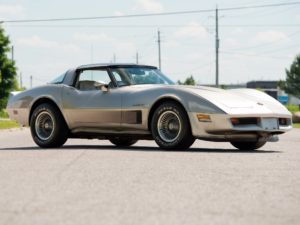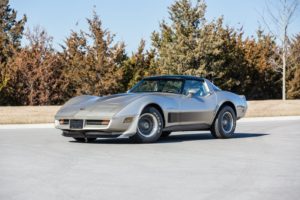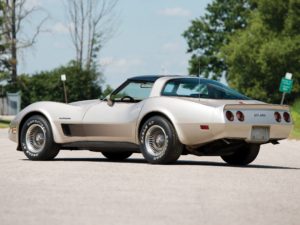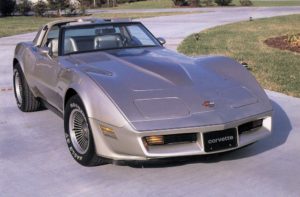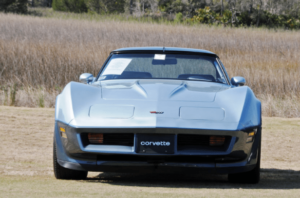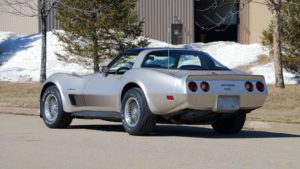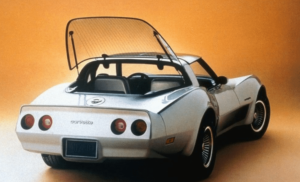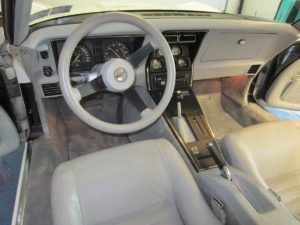While most of the design specifics surrounding the new C4 Corvette model were still a carefully kept secret from the general public, it was known amongst automotive enthusiasts that a new model was coming and that it would be another front-engine design keeping in the tradition of Corvette since 1953.
Despite the certainty that the next-generation Corvette was close at hand, a decision was made by General Motors brass to continue production of the existing Corvette for one final year.
Chevrolet executives knew that testing out new manufacturing machinery and developing standardized assembly procedures made more sense when working on a familiar design, rather than trying to develop all of these production standards while simultaneously attempting to manufacture an all-new vehicle. Hence, the 1982 Corvette would, for one last model year, continue to be a third-generation model.
Pricing: $21,800.00 (Base Coupe)
Engine options: 350ci, 200HP Engine (standard)
Transmission: 4-speed automatic transmission
Units Produced: 25,407
Available Colors: White, Silver, Black, Silver Blue, Dark Blue, Bright Blue, Charcoal, Silver Green, Gold, Silver Beige, Red, Dark Claret, White/Silver, Silver/Charcoal, Silver/Dark Claret, Silver Blue/Dark Blue
Highlights of the year:
Chevrolet recognized that it did not make sense to release a new drivetrain at the same time as a new overall design, so it was decided that the 1982 C3 Corvette would be fitted with the revised engine and transmission developed for the new C4.
Although Corvette fans would actually end up waiting nearly 18 months before they’d finally be able to see the re-designed fourth-generation Corvette, they were able to see the future Corvette’s engine and drivetrain immediately.
The new engine was essentially the time-proven 350 cubic-inch V-8 that had powered Corvettes since the mid-1950’s, though it now came equipped with a newly developed twin throttle-body fuel-injection system instead of a carburetor.
The result of this change was the introduction of the first production Corvette “fuelie” since 1965. However, this wasn’t fuel injection of the type that had been available like that found from 1957 thru 1965. Instead, it featured an injector unit within a carburetor-like throttle body for each cylinder bank (a total of two injectors), while a crossover intake manifold fed the air/fuel mixture to the bank on its opposite side. This process sped up mixture velocity for more complete combustion, which resulted in greater thermal efficiency and power, plus the added benefit of reduced emissions.
Improved Computer Command Control (CCC) electronics, a technology that first appeared along with the lG4 California V-8 engine in 1980, governed the duration of injector opening in response to signals from various engine-mounted sensors.
The new CCC was capable of making eighty adjustments per second (compared to just ten adjustments per second on earlier versions of the system). The fuel delivery system was given the name “Cross Fire Injection.” The “Cross Fire” 350 was given the engine designation L83, and was rated at a respectable 200 bhp at 4,800 rpm, which was a 10 horsepower increase over the 1981 Corvette’s L81 engine.
Similarly, only a single transmission option was offered in 1982. While a manual gearbox had been available in every Corvette built since 1955, the 1982 Corvette was only offered with a standard four-speed automatic transmission.
Other mechanical changes to the 1982 Corvette included the addition of an in-tank electric fuel pump as well as a new fuel metering system which included a positive fuel cutoff to prevent engine run-on (dieseling.)
To celebrate the departure of the third-generation Corvette, Chevrolet decided to offer a final commemorative “Collectors Edition” model. However, recalling their experience with the 1978 Pace Car Replicas – namely, the number of bogus Pace Cars that were created by consumers who converted base level coupes into Pace Car “clones” – it was decided that the 1982 Collector Edition Corvettes would be built only “as needed” to satisfy customer orders. Additionally, unique vehicle identification plates were affixed to help further deter someone from turning a standard car into a Collectors Edition knock-off.
Due in large part to the Cross-Fire Fuel Injection system and the improved horsepower output of the 350 cubic-inch engine, the final C3 small-block Chevy engine showed definite performance improvements. This occurred despite its performance limitations as the result of Corvette not offering a manual transmission in 1982. Road & Track magazine timed the ’82 Corvette’s quarter-mile time at 16.1 seconds, running at a speed of 84.5 miles per hour and accelerating from 0 to 60 miles per hour in just 7.9 seconds.
Throughout its fifteen-year production run, the third-generation C3 Corvette was able to solidify itself as a true survivor. Throughout the sixties and seventies, the Corvette had been plagued with a number of challenging events – including oil embargoes and increasing emissions standards – yet the car persevered. While the “Shark” model of Corvette underwent a number of mechanical, and cosmetic changes, it never lost sight of the car’s essential mission and character.
Photos of the 1982 Corvette:
